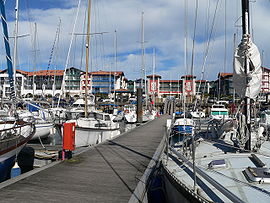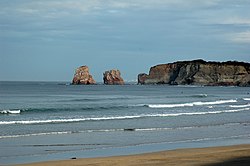
Bayonne is a city in Southwestern France near the Spanish border. It is a commune and one of two subprefectures in the Pyrénées-Atlantiques department, in the Nouvelle-Aquitaine region.

Biarritz is a city on the Bay of Biscay, on the Atlantic coast in the Pyrénées-Atlantiques department in the French Basque Country in southwestern France. It is located 35 kilometres (22 mi) from the border with Spain. It is a luxurious seaside tourist destination known for the Hôtel du Palais, its seafront casinos, and its surfing culture.

Saint-Jean-de-Luz is a commune in the Pyrénées-Atlantiques department, southwestern France. Saint-Jean-de-Luz is part of the Basque province of Labourd (Lapurdi).
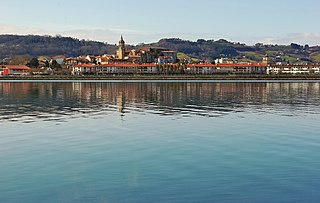
Hondarribia is a town situated on the west shore of Bidasoa river's mouth, in Gipuzkoa, in Basque Country, Spain.

Gipuzkoa is a province of Spain and a historical territory of the autonomous community of the Basque Country. Its capital city is Donostia-San Sebastián. Gipuzkoa shares borders with the French department of Pyrénées-Atlantiques at the northeast, with the province and autonomous community of Navarre at east, Biscay at west, Álava at southwest and the Bay of Biscay to its north. It is located at the easternmost extreme of the Cantabric Sea, in the Bay of Biscay. It has 66 kilometres of coast land.

Irun is a town of the Bidasoaldea region in the province of Gipuzkoa in the Basque Autonomous Community, Spain.
The place-name Bidasoa-Txingudi is a recent creation, combining the name of the river Bidasoa, which here provides a natural frontier between France and Spain in the Basque Country, with that of a bay on the French side of the estuary, the Bay of Txingudi.

Arbonne is a commune in French Basque Country, a region of the Pyrénées-Atlantiques department in the Nouvelle-Aquitaine region of southwestern France.

Ascain is a commune in the Pyrénées-Atlantiques department in the Nouvelle-Aquitaine region of south-western France.

Bassussarry is a commune in the Pyrénées-Atlantiques department in the Nouvelle-Aquitaine region of southwestern France.

Boucau is a commune in the Pyrénées-Atlantiques department and Nouvelle-Aquitaine region of south-western France. It is located in the former province of Labourd.

Urrugne is a village and a commune in the Pyrénées-Atlantiques department in south-western France. It is part of the traditional Basque province of Labourd.

Arrast-Larrebieu is a commune in the Pyrénées-Atlantiques department in the Nouvelle-Aquitaine region of south-western France.
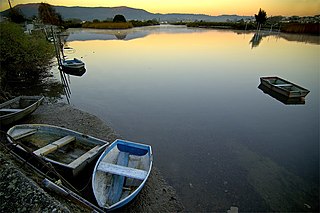
The Bidasoa is a river in the Basque Country of northern Spain and southern France that runs largely south to north. Named as such downstream of the village of Oronoz-Mugairi in the province of Navarre, the river actually results from the merger of several streams near the village Erratzu, with the stream Baztan that rises at the north-eastern side of the mount Autza being considered the source of the Bidasoa. It joins the Cantabrian Sea between the towns of Hendaye and Hondarribia.
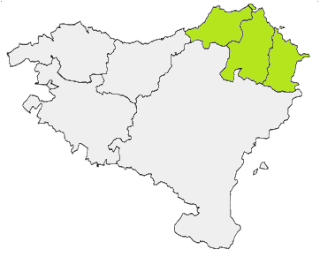
The French Basque Country, or Northern Basque Country, is a region lying on the west of the French department of the Pyrénées-Atlantiques. Since 1 January 2017, it constitutes the Basque Municipal Community presided over by Jean-René Etchegaray.
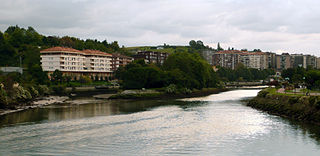
Pheasant Island is an uninhabited river island located in the Bidasoa river, located between France and Spain, whose administration alternates between the two nations every 6 months.

The Bay of Txingudi is a bay in the right or French bank of the estuary of the Bidasoa river, near Hendaye in the département of Pyrénées-Atlantiques in south-west France. It faces the town of Hondarribia and the airport of San Sebastián in the Gipuzkoa province of the Basque Country, in north-eastern Spain. The border between the two countries passes through the Bidasoa estuary. It is an important area for bird-watching.
The canton of Hendaye-Côte Basque-Sud is an administrative division in southern France. At the French canton reorganisation which came into effect in March 2015, the canton was renamed and reduced from 4 to 3 communes:

The 6th constituency of the Pyrénées-Atlantiques is a French legislative constituency in the Pyrénées-Atlantiques département. Like the other 576 French constituencies, it elects one MP using the two-round system, with a run-off if no candidate receives over 50% of the vote in the first round.
The Eurociudad Vasca Bayonne-San Sebastián is the name given to the urban cross-border region located between Spain and France along the coast of the Cantabrian Sea in the Bay of Biscay.
